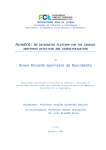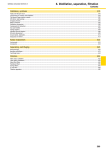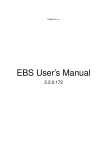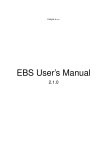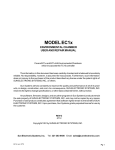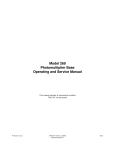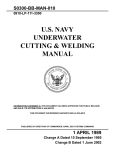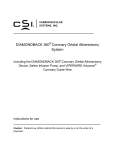Download AAMI EC11 - Electrical, Computer & Biomedical Engineering
Transcript
American National Standard ANSI/AAMI EC11:1991/(R)2001 Diagnostic electrocardiographic devices This is a sample of the AAMI EC11 for noncommercial, edicational purposes. The following pages are excluded: pp. 27-37, 42-55, and 59-60. For the complete original document, please purchase it at www.aami.org. AAMI Association for the Advancement of Medical Instrumentation Association for the Advancement of Medical Instrumentation 1110 N. Glebe Rd., Suite 220 Arlington, VA 22201-4795 © 2000 by the Association for the Advancement of Medical Instrumentation All Rights Reserved Copyright and Permissions Publication, reproduction, photocopying, storage, or transmission, electronically or otherwise, of all or any part of these documents without the prior written permission of the Association for the Advancement of Medical Instrumentation or the copyright holder (if not AAMI) is prohibited by law. It is illegal under federal law (17 U.S.C. § 101, et seq.) to make copies of all or any part of these documents (whether internally or externally) without the prior written permission of the copyright holder. Violators risk legal action, including civil and criminal penalties, and damages of $100,000 per offense. For permission regarding the use of all or any part of these documents, contact AAMI, 1110 N. Glebe Road, Suite 220, Arlington, VA 22201-4795. Phone: (703) 525-4890; Fax: (703) 525-1067. Violators of this copyright policy should be reported to AAMI’s legal counsel: McKenna & Cuneo, L.L.P. 1900 K Street, N.W. Washington, DC 20006 Attn: Jacqueline A. Henson, Esq. Phone: (202) 496-7500 EC11 Diagnostic electrocardiographic devices Diagnostic electrocardiographic devices ANSI/AAMI EC11:1991/(R)2001 (Revision of ANSI/AAMI EC11:1982 and ANSI/AAMI EC11a:1984) American National Standard Diagnostic electrocardiographic devices Developed by Association for the Advancement of Medical Instrumentation Approved 24 October 1991 and reaffirmed 4 May 2001 by American National Standards Institute Abstract: This standard establishes minimum safety and performance requirements for electrocardiographic (ECG) systems with direct writing devices which are intended for use in ECG contour analysis for diagnostic purposes. Committee representation Association for the Advancement of Medical Instrumentation This standard was developed by the Diagnostic Electrocardiograph Subcommittee under the auspices of the Electrocardiograph Committee. Committee approval of the standard does not necessarily imply that all committee and subcommittee members voted for its approval. The AAMI Electrocardiograph Committee has the following members: Cochairpersons: Stanley A. Briller, M.D. David Mortara, Ph.D. Members: James Bailey, M.D., National Institutes of Health Alan S. Berson, Ph.D., National Heart, Lung and Blood Institute Stanley A. Briller, M.D., Allegheny General Hospital, Pittsburgh, PA Francis Charbonnier, Ph.D., Hewlett-Packard Company David L. Daly, Center for Devices and Radiological Health, FDA Arthur R. Eddy, Jr., Medtronic, Inc David Mortara, Ph.D., Mortara Instruments *Jim Rooks, Medical Data Electronics Alternates: Robert Cangelosi, Center for Devices and Radiological Health, FDA Peter Galen, Hewlett-Packard Company Roy D. Wallen, Hewlett-Packard Company The committee's Diagnostic Electrocardiograph Subcommittee has the following members: Cochairpersons: Alan S. Berson, Ph.D. © 2000 Association for the Advancement of Medical Instrumentation Peter Galen Members: William O. Adams, Physio-Control Corp. Manolito Adan, SpaceLabs Medical, Inc. Alan S. Berson, Ph.D., National Heart, Lung and Blood Institute Stanley A. Briller, M.D., Allegheny General Hospital, Pittsburgh, PA Stephen Daleo, PPG Biomedical Systems David L. Daly, Center for Devices and Radiological Health, FDA James Dobbins, University of Kansas Medical Center, Kansas City, KS Melvin N. Fink, Servicemaster Peter Galen, Hewlett-Packard Company David Geselowitz, Ph.D., Pennsylvania State University Pradeep M. Gupte, Westchester County Medical Center, Valhalla, NY David Hernke, Marquette Electronics Inc. Haim Klement, Datascope Corp. Jeffrey P. Milsap, CCE, PE, Ohmeda Anesthesia Systems Kay Rutishauser, RN, American Association of Critical Care Nurses William J. Smirles, R2 Medical Systems John G. Webster, Ph.D., University of Wisconsin Alternates: David Brown, Jr., SpaceLabs Medical, Inc. Robert Cangelosi, Center for Devices and Radiological Health, FDA Francis Charbonnier, Ph.D., Hewlett-Packard Company Martin J. Kutik, PPG Biomedical Systems (PPD Consulting) Ian Rowlandson, Marquette Electronics Inc. NOTE—Participation by federal agency representatives in the development of this standard does not constitute endorsement by the federal government or any of its agencies. Foreword This is the second edition of the American National Standard, Diagnostic electrocardiographic devices. The standard, which was developed by the AAMI ECG Committee and its Diagnostic Electrocardiograph Subcommittee and first approved in 1983, is based on the fourth draft of a standard for electrocardiographic (ECG) devices developed by the UBTL Division of the University of Utah Research Institute under the sponsorship of the then Bureau of Medical Devices, U.S. Food and Drug Administration. The objective of this standard is to provide minimum labeling, performance, and safety requirements that will help ensure a reasonable level of clinical efficacy and patient safety in the use of diagnostic ECG devices. Substantive changes from the original standard appear in this revision. In 1990, the American Heart Association published a new report, updating their recommendations of 1975. The subcommittee carefully considered these recommendations in developing this revision of the AAMI standard. The changes in this revision primarily affect frequency response requirements, direct currents in patient electrode connections, system noise, and defibrillator overload protection. This standard, like any other, must be reviewed and updated periodically to assimilate progressive technological developments. In addition, as other standards relevant to diagnostic ECG devices are promulgated, they may be incorporated by reference in order to provide additional assurance of safety and efficacy with respect to such characteristics as electromagnetic interference protection and performance of the device under adverse environmental conditions. This standard reflects the conscientious efforts of concerned health care professionals, device manufacturers, © 2000 Association for the Advancement of Medical Instrumentation and government representatives to develop a standard for those performance levels that could be reasonably achieved at this time. Recommendations for improving this standard are invited. Comments and suggested revisions should be sent to: AAMI, 3330 Washington Boulevard, Suite 400, Arlington, VA 22201-4598. NOTE—This foreword is not a part of the American National Standard, Diagnostic electrocardiographic devices (ANSI/AAMI EC11-1991). Diagnostic electrocardiographic devices 1 Scope This standard establishes minimum safety and performance requirements for electrocardiographic (ECG) systems with direct writing devices which are intended for use, under the operating conditions specified in this standard, in the analysis of rhythm and of detailed morphology of complex cardiac complexes. Subject to this standard are all parts of the electrocardiographic system necessary to obtain the signal from the surface of the patient's body, to amplify this signal, and to display it in a form suitable for diagnosing the heart's electrical activity. This standard defines requirements for the electrocardiographic recording system, from the input electrodes1) to the output display. NOTE—The safety and performance criteria defined in this standard are intended principally for use in design qualification or evaluation by the manufacturer. The referee test methods of section 4 are intended to provide means by which conformance with the standard can be established unambiguously. These tests are not intended for use in verifying the performance of individual devices, either for purposes of quality assurance inspections by the manufacturer or for purposes of routine inhospital inspections. Also, referee tests, by definition, allow for the use of alternative methods for design qualification, provided that the equivalence of the methods can be established in terms of comparability of test results with those of the referee methods. 1.1 Inclusions Included within the scope of this standard are the following devices: a) direct-writing electrocardiographs; b) electrocardiographs used in other medical devices (e.g., patient monitors, defibrillators, stress testing devices), when such devices are intended for use in obtaining diagnostic ECG signatures; c) electrocardiographs having a display that is remote from the patient (via cable, telephone, telemetry, or storage media), when such devices are intended for use in obtaining ECG signatures. These devices are subject to the functional performance requirements at the system output-input levels2). 1.2 Exclusions Not included within the scope of this standard are: a) devices that collect ECG data from locations other than the external surface of the body; b) devices for interpretation and pattern recognition (e.g., QRS detectors,alarm circuits, rate meters, diagnostic algorithms); c) fetal ECG monitors; d) ambulatory monitoring electrocardiographic devices, including ECG recorders and associated scanning and read-out devices; e) diagnostic electrocardiographic devices utilizing nonpermanent displays; © 2000 Association for the Advancement of Medical Instrumentation f) vectorcardiographs, that is, the display of loops; g) electrocardiographic devices intended for use under extreme or uncontrolled environmental conditions outside of a hospital environment or physician's office; h) cardiac monitors, with or without heart rate meters and alarms, that are intended primarily for detecting cardiac rhythm. (These devices are covered by the ANSI/AAMI standard Cardiac monitors, heart rate meters and alarms.) NOTE—Devices that provide selection between diagnostic and monitoring functions must meet the requirements of the appropriate standard—the standard for diagnostic electrocardiographic devices or the standard for cardiac monitors, heart rate meters and alarms—when selected for that function. 2 Normative references 2.1 Applicable documents The following documents are applicable to the extent specified herein. 2.1.1 ASSOCIATION FOR THE ADVANCEMENT OF MEDICAL INSTRUMENTATION. Safe current limits for electromedical apparatus. ANSI/AAMI ES1-1985. Arlington (Vir.): AAMI, 1985. American National Standard. ISBN 0-910275-50-5. 2.1.2 ASSOCIATION FOR THE ADVANCEMENT OF MEDICAL INSTRUMENTATION. Cardiac defibrillator devices. ANSI/AAMI DF2-1989. Arlington (Vir.): AAMI, 1989. American National Standard. ISBN 0-910275-91-2. 2.2 Reference standards Reference may be made to the following standards for safety and performance criteria established for other electrocardiographic devices and for components of electrocardiographic recording systems. 2.2.1 ASSOCIATION FOR THE ADVANCEMENT OF MEDICAL INSTRUMENTATION. Cardiac monitors, heart rate meters and alarms. ANSI/AAMI EC13-1983. Arlington (Vir.): AAMI, 1983. American National Standard. ISBN 0-910275-42-4. 2.2.2 ASSOCIATION FOR THE ADVANCEMENT OF MEDICAL INSTRUMENTATION. Disposable ECG electrodes. ANSI/AAMI EC12-1991. Arlington (Vir.): AAMI, 1991. American National Standard. ISBN 0-910275-61-0. 2.2.3 ASSOCIATION FOR THE ADVANCEMENT OF MEDICAL INSTRUMENTATION. Standard for ECG connectors. ANSI/AAMI ECGC-1983. Arlington (Vir.): AAMI, 1983. American National Standard. ISBN 0-910275-21-1. 3 Requirements 3.1 Labeling requirements In addition to federal regulations applicable to the labeling of all medical devices, the requirements of this section shall apply to all devices within the scope of this standard. 3.1.1 Device markings 3.1.1.1 Product identification and characteristics Diagnostic ECG devices shall be clearly and permanently marked with the following information: a) the manufacturer's name, trademark, trade name, or other recognizable identification; © 2000 Association for the Advancement of Medical Instrumentation b) the catalogue, style, model, or other type designation; c) the serial number; d) the range of supply (mains) voltage and the maximum operating current or power; e) the nominal supply (mains) frequency; f) the number of phases, unless the device is intended for single-phase use only; g) the current-carrying capacity of each convenience receptacle and/or identification of the instrument(s) which can be connected to it if the device provides mains power for other devices. 3.1.1.2 Panel controls and switches All controls, switches, and connectors shall be clearly and concisely labeled to identify their function. 3.1.1.3 Electrical safety Where markings are affixed to the electrocardiograph warning maintenance personnel of the potential shock hazard from accidental contact with parts, or identifying electrocardiographs with current ratings that may overload branch circuits supplying the electrocardiograph, these markings shall be placed in locations suitable for the intended use and shall be clearly visible. NOTE—Markings that are inside the enclosure of the equipment shall be considered clearly visible if they can be viewed when the connections to the supply are being made or inspected. Markings that are inside the enclosure of cord-connected equipment are considered to be clearly visible if the markings would be seen before a hazard is encountered. 3.1.1.4 Fuse holders If fuse holders accessible to the operator are provided, they shall be clearly marked with the applicable fuse rating, in amperes, and with the fuse type. 3.1.1.5 Patient-electrode connection nomenclature and colors Colors, if used, shall be associated with either individually colored patient lead conductors and/or if plug bodies are used, with the bodies at the electrode ends. Cable legends of a permanent type (e.g., engraved) shall also be used for individual patient-electrode connection identification. The standard color code for patient lead conductors, as well as electrode placement, shall conform to the specifications of table 1. NOTE—See A.3.1.1 for information concerning the differences between the color code specified in this requirement and that recommended by the International Electrotechnical Commission (IEC). 3.1.2 Operator's manual An operator's manual, containing adequate instructions for the proper installation and the safe and effective operation of the device and identifying acceptable repair facilities, shall be provided with each unit (or in the case of multiple orders, as specified in the purchase contract). At least the following information shall be supplied. © 2000 Association for the Advancement of Medical Instrumentation Table 1—Patient electrode connection definitions and color code Patient electrode System connection identifier ConvenRA tional LA LL V V1 V2 V3 V4 V5 V6 RL Frank I vector E C A M H F Color code White Black Red Brown Brown/red Brown/yellow Brown/green Brown/blue Brown/orange Brown/violet Green Orange/red Orange/yellow Orange/green Orange/brown Orange/black Orange/violet Red Position on body surface Right arm Left arm Left leg Single movable chest electrode 4th intercostal (IC) space at right border of sternum 4th IC space at left border of sternum Midway between V2 and V4 5th IC space on left midclavicular line Left anterior axillary line at the horizontal level of V4 Left midaxillary line at the horzontal level of V4 Right leg At the right midaxillary line 1) At the front midline1) Betweeen front midline and left midaxillary line at angle of 45 degrees At the left midaxillary line1) At the back midline1) On the back of the neck or on the forehead On the left leg 1)Located at the transverse level of the ventricles (i.e., 5th interspace at the left sternal border). 3.1.2.1 Disclosure of cautionary information/ performance characteristics a) Cautionary information. Cautionary information and prominent labeling shall be provided, where possible use or exposure could create a potential hazard or could damage the electrocardiograph, including, but not limited to, use of the device in the vicinity of explosive anesthetics and use in the presence of electromagnetic interference or power overloads caused by electrosurgical or diathermy instruments. b) Battery-powered devices. For ECG devices equipped with batteries, the manufacturer shall disclose the minimum operating time of the device and of any connected accessories, provided that the batteries are new and fully charged. For rechargeable batteries, the manufacturer shall disclose the battery charge time from depletion to 90 percent charge. In addition, if a battery depletion indicator is provided, its function shall be described. c) Accuracy of input signal reproduction. The manufacturer shall disclose the methods used to establish overall system error and frequency response. The system may be tested in either of two ways, as described in 3.2.7.2 and 4.2.7.2. Because of their sampling characteristics and the asynchronism between sample rate and signal rate, digital systems may produce a noticeable modulating effect from one cycle to the next, particularly in pediatric recordings. This phenomenon, which is not physiologic, shall be clearly described in the operator's and service manuals. d) Electrode polarization. The manufacturer shall describe the need to pay special attention to the type of electrodes used, since some electrodes may be subject to large offset potentials due to polarization. Recovery time after application of defibrillator pulses may be especially compromised. Squeeze bulb electrodes commonly used for diagnostic ECG recording may be particularly vulnerable to this effect. 3.1.2.2 Applications notes Appropriate information concerning the application of the device shall be provided, including but not limited to: © 2000 Association for the Advancement of Medical Instrumentation a) a description of the device's intended application and available functions; b) the procedures for checking proper operation of all controls and functions of the device; c) the manufacturer's recommendations concerning type(s) of electrodes that should be used with the device to ensure conformance of the device with the requirements of this standard, as well as a clear warning that electrodes of dissimilar metals should not be used unless the amplifier can handle polarization potentials as high as 1 volt (V). 3.1.3 Service manual A service manual, containing adequate care, preventive maintenance, and repair instructions, shall be provided with each unit upon request (or, in the case of multiple orders, as specified in the purchase contract). These instructions shall include items such as electronic circuit schematics, test points, waveforms, logic and/or block diagrams, wiring diagrams, parts lists, and component values. This information shall be complete enough to allow a skilled technician to accomplish reasonable field repair, calibration, and other maintenance needed to ensure conformance of the device with the manufacturer's specifications. In addition, the instructions shall identify acceptable repair facilities and include recommendations concerning (a) test methods that can be used for verification of device performance, and (b) the frequency with which preventive maintenance procedures should be implemented. A copy of the operator's manual shall be available to service personnel. NOTE—The operator's and service manuals may be combined if desired. 3.1.4 Summary Table 2 provides a summary of the labeling/disclosure requirements of this standard. 3.2 Performance requirements 3.2.1 Operating conditions Unless otherwise stated, the performance requirements of this standard shall be met under the following ambient environmental conditions: Line voltage: Line frequency: Temperature: Relative humidity: Atmospheric pressure: 104 to 127 volts (V) rms 60 ± 1 Hz 25 ± 10°C 50 ± 20 percent, noncondensing 7 x 104 to 10.6 x 104 Pa (700 to1060 mbar) NOTE—These ranges of operating conditions are not intended to provide assurance of the safety and effectiveness of devices intended for use under extreme or uncontrolled environmental conditions outside of a hospital environment or physician's office. Such devices are excluded from the scope of this standard. 3.2.2 Lead definition The definitions of lead sets employing the 12 conventional or orthogonal (Frank) leads shall conform to table 3. The voltage difference is defined algebraically in the second column of the table (see 3.2.7.4 for coefficient tolerances). Single-channel ECG devices shall provide lead selection of at least the first seven leads in table 3. Three-channel devices shall provide selection of at least the first 12 leads of table 3. 3.2.3 Input dynamic range The ECG device shall be capable of responding to and displaying differential voltages of ± 5 millivolts (mV) varying at a rate up to 320 mV per second (s) from a dc offset voltage in the range of -300 mV to +300 mV, when applied to any lead. The time-varying output signal amplitude shall not change by more than ± 5 © 2000 Association for the Advancement of Medical Instrumentation percent over the specified range of dc offset. 3.2.4 Gain control, accuracy, and stability 3.2.4.1 Gain settings and accuracy The device shall provide fixed gain selections of 20 mm/mV, 10 mm/mV, and 5 mm/mV, with a gain accuracy of ± 5 percent. 3.2.4.2 Gain control Continuously variable gain control may be provided if this mode is clearly indicated on the device control panel and if the recorded output indicates when this option is in use. 3.2.4.3 Gain switching If automatic gain change or switching is provided, the recorded output shall indicate whenever the gain is changed. Any automatic gain switching shall have a manual override. 3.2.4.4 Gain stability The gain change 1 minute after energizing the device shall not exceed 0.33 percent per minute. The total change in 1 hour shall not exceed ± 3 percent of any available fixed gain setting. NOTE—Devices that provide simultaneous permanent records and nonpermanent displays need not provide the same gain for both. 3.2.5 Time base selection and accuracy 3.2.5.1 Time base selection The device shall provide at least two time bases: 25 mm/s and 50 mm/s. © 2000 Association for the Advancement of Medical Instrumentation Table 2—Summary of labeling/disclosure requirements Section 3.1.1/3.1.1.1 3.1.1.2 3.1.1.3 3.1.1.4 3.1.1.5 3.1.2/3.1.2.1 3.1.2.1a 3.1.2.1b 3.1.2.1c 3.1.2.1d 3.1.2.2 3.1.3 Requirement desciption Device markings/product identification and characteristic: manufacturer's identification name type designation; serial number; range of supply voltage and maximum operating current/power; nominal supply frequency; number of phases; current-carrying capacity of convienience receptacle. Panel controls and switches: identification of controls, switches, connectors. Electrical safety: readily visible markings for shock hazard and/or overcurrent ratings. Fuse holders: fuse ratings in amperes and fuse type. Patient electrode connection nomenclature and colors: conformance with table 1, if applicable. Operator's manual: disclosure of cautionary information/performance characteristics Cautionary information: cautionary information regarding potential hazards/damage, including warnings on use of device in presence of explosive anesthetics and use of device in presence of electromagnetic interference or power overload caused by electrosurgical or diathermy instruments. Battery-powered devices: minimum operating time; battery charge time; function of battery depletion indicator, if provided. Accuracy of input signal reproduction: description of methods used by manufacturer to establish overall system error and frequency response; desciption of modulating effects in digital systems. Electrode polarization: cautionary statement concerning effect of electrode type on system recovery form overload, especially recovery time after defibrillator pulses. Applications notes: desciption of device's intended applications and available functions; procedures for checking controls and functions; manufacturer's recommendations concerning electrodes. Service manual: adequate care, preventive maintenance, and repair instructions; electrical specifications complete enough to allow reasonable field repair; identification of acceptable repair facilities; recommended frequency of preventive maintenance. 3.2.5.2 Time base accuracy The time base accuracy shall allow measurements of time with an error of less than ± 5 percent, for time intervals between 0.2 and 2.0 s. 3.2.6 Output display 3.2.6.1 Input signals The output display shall accommodate the signals specified in 3.2.3. 3.2.6.2 Channel width The display width per channel shall be no less than 40 mm. 3.2.6.3 Trace width and visibility The trace shall be visible at writing rates corresponding to 320-mV/s input signal rates, at a gain no lower than 5 mm/mV. The trace width shall not exceed 1 mm. NOTE—User adjustment may be provided to fulfill this requirement. 3.2.6.4 Rectangular coordinates/alignment of writing points ECG devices shall provide recordings in rectangular coordinates. Departure from time axis alignment of the writing points of a multichannel electrocardiograph shall be less than 0.5 mm or indicated 10 ms, whichever is greater. © 2000 Association for the Advancement of Medical Instrumentation Table 3—Definition of leads Lead nomenclature I II III aVR aVL aVF V1 Definition1) I = LA - RA II = LL - RA III = LL - LA aVR = RA - 0.5 (LA + LL) aVL = LA - 0.5 (LL + RA) aVF = LL - 0.5 (LA + RA) V1 = V - 0.333 (LA + RA + LL)2) V2 V3 V4 V5 V6 X Y Z V2 = V - 0.333 (LA + RA + LL) V3 = V - 0.333 (LA + RA + LL) V4 = V - 0.333 (LA + RA + LL) V5 = V - 0.333 (LA + RA + LL) V6 = V - 0.333 (LA + RA + LL) X = 0.610A + 0.171C - 0.781l Y = 0.655F + 0.345M - 1.000H -0.374E - 0.231C Name of lead Bipolar limb leads (Einthoven) Augmented leads (Goldberger) Unpolar chest leads (Wilson) Orthogonal vector leads (Frank)3) 1) The definition is given in terms of algerbraic equations, assuming that the electrode identifier represents the voltage sensed by the elctrode. See table 1 for a list of definitions of patients electrode connection identifiers. 2) For the unipolar chest leads, V represents the potential at each respective chest electrode location: i.e., for voltage V1, V represents the potential at wlwctrode location V1; for voltage V2, V represents the potential at electrode location V2; and so forth. 3) By convention, X is oriented horizontally and towards the left arm of the patient, Y points towards the feet, and Z is horizontal and towards the back of the patient. 3.2.6.5 Time and amplitude rulings Rulings on preprinted recording media shall be in rectangular coordinates, with the time lines perpendicular to the edge of the recording medium with a maximum error of 0.5 percent of the effective recording width of the recording medium (e.g., 0.2 mm for a 40-mm width). Nominal ruling shall be 1 mm, major ruling 5 mm, with a tolerance of ± 2 percent for the environmental operating conditions specified in 3.2.1. 3.2.6.6 Time and event markers When provided, markers shall not produce unwanted deflections greater than 0.5 mm in any channel at any gain setting. Time marker generation shall be accurate with an error of no greater than ± 2 percent of the timing interval(s) specified by the manufacturer. Recorders (such as photorecorders) that generate the grid markers shall be capable of time marking at 0.1 and 0.2 s, with a maximum error of ± 2 percent. 3.2.6.7 Reduced performance modes Any operator adjustment or control which allows degrading of performance for any reason shall, when activated, result in an indication on the recording medium of this reduced performance mode. 3.2.7 Accuracy of input signal reproduction 3.2.7.1 Overall system error Input signals, limited in amplitude and rate of change to ± 5 mV and 125 mV/s, respectively, shall be reproduced on the output recording medium with a maximum instantaneous deviation from the ideal of ± 5 percent or ± 40 microvolts (µV), whichever is greater. © 2000 Association for the Advancement of Medical Instrumentation Method A B C D Nominal input amplitude (mV p-p) 1.0 0.5 0.25 0.5 1.5 Table 4—Frequency response Relative output Input frequency response and waveform (mm) 0.67 to 40 Hz, sinusoidal ± 10% 1) 40 to 100 Hz, sinusoidal + 10%, - 30%1) 100 to 150 Hz, sinusoidal + 10%, - 30%1) 150 to 500 Hz, sinusoidal + 10%, - 100%1) ≤ 1 Hz, 20 ms, triangular + 0, - 10% 2) 1) relative to 10-Hz output 2)relative to 200-ms output Figure 1—Triangular wave signal (for 3.2.7.2, Method D) 3.2.7.2 Frequency and impulse response The device shall exhibit a frequency response conforming to the specifications of table 4, at a gain setting of 10 mm/mV. NOTE—The device must meet the requirements of Methods A and D, or alternately, the requirements of all of Methods A, B, and C of table 4. The manufacturer must disclose which of the two sets of requirements (or both) are met (see 3.1.2.1[3]). For Methods A, B, and C, the output response is relative to that obtained at 10Hz. For Method D, the output response is relative to that obtained for a repetitive, triangular wave signal with a base width of 200 ms and a repetition rate of 1 Hz or less (figure 1). Additionally, the device shall respond to an impulse as follows: a) A 0.3 mV-s (3 mV for 100 ms) impulse input shall not produce a displacement greater than 0.1 mV outside the region of the impulse. b) For a 0.3 mV-s (3 mV for 100 ms) impulse input, the slope of the response shall not exceed 0.30 mV/s following the end of the impulse. 3.2.7.3 Lead weighting factors ECG devices employing standard lead sets shall use lead weighting factors as specified in table 3. Weighting factors shall be accurate to within ± 5 percent. 3.2.7.4 Hysteresis The hysteresis of the permanent recording system shall not exceed 0.5 mm, after a deflection of 15 mm in either direction from baseline. In addition, the device shall exhibit a "response to minimum signal": a 10-Hz, 20-µV peak-to-peak (p-p) sinusoidal signal shall yield a visible recorded deflection at a time base of © 2000 Association for the Advancement of Medical Instrumentation 25 mm/s and a gain setting of 10 mm/mV. 3.2.8 Standardizing voltage A standardizing voltage shall be provided having a value and form that produce a step change in display output whose amplitude is within ± 5 percent of the step amplitude obtainable by applying a 1.00 ± 0.01-mV signal at the appropriate lead. The standardizing voltage provided to test this step response shall exhibit a rise time of less than 1 ms and a decay time constant of at least 100 s. The standardizing signal shall provide an indication of operator adjustment of the gain. The signal shall be applied to all available channels of multichannel recorders. An alternate waveform for the standardizing voltage, consisting of a pulsed triangular waveform with peak amplitude within ± 5 percent of the step amplitude obtained by applying a 1.00 ± 0.01-mV signal at the appropriate lead, is acceptable. The base width of this monophasic triangular waveform shall be 100 ± 5 ms. 3.2.9 Input impedance An electrode-to-skin impedance, simulated by a 0.62-megohm resistor in parallel with a 4.7-nanofarad (nF) capacitor, in series with any patient-electrode connection, shall not result in a signal reduction of more than 20 percent of that obtained without the simulated impedance, within the bandwidth of the ECG device. This reduction shall not be exceeded with dc offset potentials as specified in 3.2.3. These requirements shall be met at all appropriate settings of the lead selector. (A single-ended input impedance of at least 2.5 megohms at 10 Hz will be needed to meet these requirements.) 3.2.10 Direct currents in patient-electrode connections The direct current through any patient-electrode connection, with all patient-electrode connections connected to a common node, shall not exceed 0.1 µA for any patient-electrode connection that serves as an amplifier input for measurement of ECG potentials, or 1 µA for any other patient-electrode connection. 3.2.11 Common mode rejection The ECG device shall have the capability of rejecting 60-Hz common mode interfering voltages as encountered on the surface of the body. With all patient-electrode connections connected to a common node through a 51-kilohm resistor and a 47 nF capacitor including RL, if supplied, a 60-Hz, 20-V rms signal applied to the common node through a 100-pF capacitor shall not produce an output signal exceeding 1 mV p-p referred-to-input (RTI) over a 60-s period. This requirement shall be met with sequential shorting of the series-impedance-simulating lead imbalance in each active lead and with a dc offset potential placed in series with any patient-electrode connection, as specified in 3.2.3. The manufacturer's recommended patient cable shall be used for verification testing. NOTE—In conducting a test to verify this capability, undesirable stray and leakage capacitances may result from shielding components and from patient cable capacitances when the cable is connected to the voltage source. The test method of 4.2.11 takes these capacitances into consideration. 3.2.12 System noise 3.2.12.1 Cable, circuit, and output display noise Noise due to the patient cables, all internal circuits, and output displays shall not exceed 30 µV p-p RTI over a 10-s period, when the manufacturer's recommended cable is used and when all inputs are connected together through a 51-kilohm resistor in parallel with a 47-nF capacitor in series with each patient-electrode connection. 3.2.12.2 Channel crosstalk Input signals limited in amplitude and rate of change as per 3.2.3, applied to any one lead of a multichannel © 2000 Association for the Advancement of Medical Instrumentation electrocardiograph and with all unused inputs connected to patient reference through a 51-kilohm resistor in parallel with a 47-nF capacitor, shall not produce unwanted output greater than 2 percent of the applied signals (multiplied by the gain) in those channels where no signal is applied. 3.2.13 Baseline control and stability 3.2.13.1 Reset A 1-V p-p, 60-Hz overload voltage shall be applied for at least 1 s to any lead. After removal of this overload voltage, provision shall be available to restore a 1-mV p-p trace to the recording width of the display within 3 s. 3.2.13.2 Baseline stability One minute after energizing the device and at least 10 s after activation of the reset function with the patient-electrode connections connected through 25-kilohm resistors, the baseline drift rate at output shall not exceed 10 µV/s RTI over any 10-s period. (The baseline is defined as the trace location 10 s after activation of the reset function.) In addition, the total baseline drift shall not exceed 500 µV RTI in any 2-minute period. The device shall incorporate means to return the output trace to within 3 mm of the baseline within 1 s of switching leads. 3.2.14 Overload protection 3.2.14.1 AC voltage The device shall meet the requirements of this standard after a 10-s application of a 1-V p-p, 60-Hz differential voltage to any patient-electrode connection with any lead selection combination. 3.2.14.2 Defibrillator overload protection 3.2.14.2.1 Recovery The electrocardiograph shall recover within 8 s after exposure of any patient-electrode connection/lead combination to simulated defibrillator discharges having a damped sinusoidal waveform conforming to the limits specified in the American National Standard, Cardiac defibrillator devices (applicable document 2.1.2). The source generator shall have a minimum stored voltage of 5000 V, and the energy delivered to the test assembly shall be 360 J. The waveforms are to be delivered at 20-s intervals into a 100 ohms load, with 400 ohms interposed between the 100 ohm defibrillator load and one connection of the ECG device. 3.2.14.2.2 Reduction in energy delivered to the patient The electrocardiograph shall incorporate current limiting devices so that the defibrillator energy delivered to the 100 ohm load is reduced by a maximum of 10 percent relative to the energy delivered to this load with the electrocardiograph disconnected. The number of required discharges shall be as specified in table 9. 3.2.14.2.3 Operator safety In the case of a device that may be operated from battery power, application of defibrillator pulses in the arrangements described above, but with the electrocardiograph disconnected from any ac wall outlet and the power switch turned off, shall not make available more than 100 microcoulombs (µC) of charge to operator-accessible chassis points or controls of the electrocardiograph. In the case of a device that may be operated from battery power, the device shall also meet this requirement while disconnected from any ac wall outlet. After this test, the device shall meet the requirements of 3.2.3 through 3.2.13 and the requirement of 3.2.15. 3.2.14.3 Pacemaker pulse display capability The device shall have the capability of displaying the ECG signal in the presence of pacemaker pulses with © 2000 Association for the Advancement of Medical Instrumentation amplitudes between 2 and 250 mV, durations between 0.1 and 2.0 ms, a rise time of less than 100 µs, and a frequency of 100 pulses/minute. For pacemaker pulses having durations between 0.5 and 2.0 ms (and amplitude, rise time, and frequency parameters as specified above), an indication of the pacemaker pulse shall be visible on the recording; this indication shall be visible on the display with an amplitude of at least 0.2 mV RTI. 3.2.15 Risk currents The device shall utilize isolated patient connections. The risk currents flowing to or from the patient through the patient-electrode connections, chassis, or controls of the electrocardiograph shall not exceed the limits specified in the American National Standard, Safe current limits for electromedical apparatus (applicable document 2.1.1). 3.2.16 Auxiliary output 3.2.16.1 Where an auxiliary output is provided, the device shall meet all specifications after removal of a short-circuit applied to the auxiliary output for 1 minute. 3.2.16.2 The risk current limits specified in 3.2.15 shall not be exceeded upon proper connection of an auxiliary device to the auxiliary output. Such proper connection shall be described in the operator's manual. 3.2.17 Summary © 2000 Association for the Advancement of Medical Instrumentation Table 5 provides a summary of the performance requirements of this standard. Table 5—Summary of performance requirements Section 3.2.1 3.2.2 3.2.3 3.2.4 3.2.5 3.2.6 3.2.7 Requirement description Operating conditions: line voltage frequency temperature relative humdity atmosphere pressure Min/ max Units range range range range range V rms Hz °C % Pa Lead definition Number of leads: single-channel three-channel Input dynamic range: range of linear operations of input signal slew rate change DC offset voltage range allowed variation of amplitude with DC offset Gain control, accuracy and stability: gain selections gain error manual override of automatic gian control gain change rate/minute total gain change/hour Time base selection and accuracy: time base selections time base error Output display: general width of display trace visibility (writing rates) trace with (permanent record only) departure from time axis alignment preruled paper division error of rulings time marker error Accuracy of input signal reproduction: overall error for signals up to ± 5 mV & 125 mV/s upper cut-off frequency (3dB) response to 20 ms, 1.5 mV triangular input response to 0.3 mV•s impulse NA NA 104 to 127 60 ± 1 25 ± 10 50 ± 20 7 x 104 to 10.6 x 104 table 3 min min NA NA 7 12 min max min mV mV/s mV ±5 320 ±300 max % ±5 min max mm/mV % 20, 10, 5 5 NA max max NA %/min % NA ± 0.33 ±3 min max mm/s % 25, 50 ±5 NA min NA mm per 3.2.3 40 max mm/s 1600 max max max min max max mm mm ms div/cm % % 1 0.5 10 10 ±2 ±2 max % ±5 max µV ±40 min mm 13.5 min max mm mV 13.5 0.1 © 2000 Association for the Advancement of Medical Instrumentation Min/max value 3.2.8 3.2.9 3.2.10 3.2.11 3.2.12 3.2.13 3.2.14 3.2.15 3.2.16 displacement slope error in lead weighting factors hysteresis after 15-mm deflection from baseline Standardizing voltage:1) nominal value rise time decay time amplitude error Input impedance at 10Hz (each lead) DC current (any input lead) DC current (any other patient electrode) Common mode rejection: allowable noise with 20 V, 60 Hz & ± 300 mV dc & 51-kilohm imbalance System noise: RTI, p-p multichannel crosstalk Baseline control and stability: retun time 10 s after reset return time after lead switch Baseline stability: baseline drift rate RTI total baseline drift RTI (2-min period) Overload protection: No damage from differential voltage, 60-Hz, 1 - V p-p, 10-s application No damage from sumulated defibrillator discharges: overvoltage energy recovery time energy reduction by defibrillator shunting transfer of charge through defibrillator chassis ECG display in presence of pacemaker pulses: amplitude pulse duration rise time frequency Risk current (isolated patient connection) Auxillary output (if provided): no damage from short circuit risk current (isolated patient connection) max mV/s 0.30 max % 5 max mm 0.5 NA max min max mV ms s % 1.0 1 100 ±5 min max megohms µA 2.5 0.1 max µA 1.0 max max mm mV 10 1 max max µV % 30 2 max s 3 max s 1 max µV/s 10 max µV 500 min V 1 NA NA max V J s 5000 360 8 max % 10 max µC 100 range range max max mV ms µs pulses/min 2 to 250 0.1 to 2.02) 100 100 as per applicable document 2.1.1 as per applicable document 2.1.1 © 2000 Association for the Advancement of Medical Instrumentation 1)Square wave pulse only; not applicable to triangular waveform. 4 Test methods This section provides referee test methods and procedures by which compliance of the device with the requirements of section 3 are verified. The paragraph numbers below correspond with those of section 3 except for the first digit; e.g., conformance with the requirement of 3.2.3 can be determined by the test method of 4.2.3. NOTE—Other tests may be used for purposes of design qualification, provided that equivalence with the referee tests can be established in terms of comparability of test results. These referee tests are not intended for use in verifying the performance of individual devices, either for purposes of quality assurance inspections by the manufacturer or for purposes of routine inhospital inspections by the device user. General instrumental and procedural requirements for conducting the tests are provided below. Test conditions Unless otherwise specified, all measurements and tests shall be performed at the standard operating conditions specified in 3.2.1. During testing of battery-powered units, the battery voltage shall be within the manufacturer's specifications. Measurement tolerances are ± 1.4°C for temperature and ± 5 percent for humidity. Filter settings, if supplied, must remain unchanged during the entire battery of tests. Test apparatus The following test instruments will be required: a) An oscilloscope with a differential input amplifier having an input impedance of at least 1 megohm and an amplitude resolution of 10 µV. The 3-dB frequency response must be at least dc to 1 MHz, with a midband amplitude accuracy of ± 5 percent; b) A voltmeter capable of measuring dc voltages in the range of 1 mV to 1 V with an accuracy of ± 1 percent; and a voltmeter or peak-to-peak (p-p) amplitude detector capable of measuring p-p sinusoidal and triangular signals, in the voltage range of 0.1 to 10 V, with an accuracy of ± 1 percent; c) Two signal generators capable of generating sinusoidal, square-wave and triangular waveforms with frequencies ranging from 0.05 to 1000 Hz. The signal generators must have adjustable voltage outputs up to at least 10 V p-p which are balanced and isolated from ground; d) A high-voltage power supply and power resistor capable of charging a 32-µF capacitor to 5000 V in less than 20 s. Test circuits Unless otherwise specified, the circuits described in the tests shall be made with resistors having a ± 5 percent tolerance for frequencies up to 1 MHz. Capacitors shall be nonpolarized, of suitable voltage rating, and have a tolerance no greater than ± 5 percent. Inductors shall also have a ± 5 percent tolerance. Test signals and output measurement Unless otherwise specified, input test signal amplitudes shall be set so that errors do not exceed ± 1 percent of the specified value for dc voltages or voltage steps. Triangular or sinusoidal test voltages shall be set within ± 2 percent of the specified p-p value. The measurement of the output signal shall be made with the paper that is generated by the direct writer or, where appropriate, from a fixed image of the signal on the oscillographic screen. When necessary, a photograph of the signal, with a superimposed known graticule in the vertical and horizontal directions, may be used. Where a requirement or test is specified in µV RTI, the corresponding output in mm is obtained by © 2000 Association for the Advancement of Medical Instrumentation multiplying the µV value by the device gain expressed in mm/mV and dividing by 1000. Distance measurements on the output traces must be made with a linear optical enlarger with a scale accurate to 0.1 mm. Distances must be expressed to the nearest 0.1 mm. The line thickness of the output trace may be as much as 1 mm; therefore, care must be taken to measure distance from points on the same edge of the trace. Figure 2 shows an example of amplitude and time measurement. Noise interference The performance tests must be conducted so as to minimize extraneous noise interference and pickup, as is good practice in recording clinical electrocardiograms. The following techniques are among the means by which this can be accomplished: a) routing the ECG cables so the area between the electrode cables is minimized; Figure 2—Example of time and amplitude measurement b) balancing and placing the oscilloscope probes to minimize extraneous interference pickup during oscilloscopic measurement of differential voltages in the mV to µV range; c) constructing test circuits, where feasible, in shielded boxes and wiring them to minimize noise. Recording conditions Standard recording conditions for the device are a gain setting of 10 mm/mV and a time base of 25 mm/s. The frequency response switches, if any, are set for the response band(s) stated by the manufacturer to be required to meet the specifications in the standard. The lead selector, if any, is to be set in the Lead I position. Tests are performed after a warm-up period of at least 15 minutes, unless otherwise indicated. 4.1 Labeling requirements Compliance with the labeling requirements of 3.1 can be verified by inspection. 4.2 Performance requirements 4.2.1 Operating conditions The environmental operating conditions are recorded and checked against the values specified in 3.2.1. Compliance with the specified line voltage range is demonstrated if the device meets all requirements of this standard at a line voltage as low as 104 V and as high as 127 V rms. 4.2.2 Lead definition Compliance with the requirements of 3.2.2 can be verified by inspection. 4.2.3 Input dynamic range The test is conducted according to the following procedure: a) Adjust the signal generator of the test circuit of figure 3, with switches S1 and S2 closed and S3 in © 2000 Association for the Advancement of Medical Instrumentation position A, to generate a 16 ± 1-Hz triangular or sinusoidal signal having zero dc voltage offset between P1 and P2. One or more complete cycle of the 16-Hz signal, at a repetition rate of 1 Hz or greater, may be used. The peak-to-peak output signal shall cover 90 percent of the maximum display width of the device. b) Connect the patient-electrode connections available to P1 or P2 as described in table 6. c) Verify that the controls of the device can be adjusted, if necessary, to generate a clearly visible triangular or sinusoidal wave. d) Measure the variation in amplitude of positive and negative peaks over at least ten complete cycles of the waveform, and verify that the variation is no greater than ± 5 percent of the original amplitude upon insertion of dc offset voltages, in turn, of -300 mV, +300 mV, -150 mV, and + 150 mV. (Switch S3 is placed in position B to insert the dc offset voltages, and S4 is used to change the offset voltages.) e) Repeat the preceding test for all physically distinct recording channels. For standard lead sets, repeat the tests for all lead configurations listed in table 6. 4.2.4 Gain control, accuracy, and stability 4.2.4.1 Gain settings and accuracy Whether ECG devices provide gain settings of 20 mm/mV, 10 mm/mV, and 5 mm/mV can be determined by inspection. Gain accuracy can be assessed by measuring the response to a 1-mV ± 1 percent pulse at each gain setting and by noting whether or not the peak deflection is within ± 5 percent of ideal. 4.2.4.2 Gain control Compliance with 3.2.4.2 can be verified by inspection. 4.2.4.3 Gain switching Compliance with 3.2.4.3 can be verified by inspection. 4.2.4.4 Gain stability The gain change can be measured by applying an external plus and minus 1-mV step voltage to a chest lead, according to the procedure of 4.2.7.3. At 1-, 15-, 30-, and 60-minute intervals after the device has been energized, and at a gain setting of 10 mm/mV, the observed change in display step amplitude between any measurement must be less than 0.3 mm. 4.2.5 Time base selection and accuracy 4.2.5.1 Time base selection That at least two time bases are provided (25 and 50 mm/s) can be determined by visual inspection and by operation of the time base selection mechanism. 4.2.5.2 Time base accuracy Time base accuracy can be determined by the following procedure: a) Connect a signal generator between any lead set of the ECG device (see table 6), and adjust the amplitude of a triangular signal to generate a signal of 5 mm p-p at 25 Hz (± 1 percent). At a time base of 25 mm/s, each peak should fall at 1-mm intervals; at 50 mm/s, each peak should fall at 2-mm intervals. b) Record for at least 6 s at each time base, disregarding or discarding the first 1 s of data in each strip. © 2000 Association for the Advancement of Medical Instrumentation c) Using calipers and a vernier scale calibrated to 0.1 mm, measure the distance between 10, 20, and 40 successive peaks; the distances must be within 10 ± 0.5 mm, 20 ± 1.0 mm, and 40 ± 2.0 mm, respectively. d) Repeat the measurements at least three times at different parts of the strip for each time base. Verify that the measurements fall within the ± 5 percent error band each time. 4.2.6 Output display 4.2.6.1 Input signals Compliance with 3.2.6.1 can be determined by inspection. 4.2.6.2 Channel width Compliance with 3.2.6.2 can be determined by inspection. 4.2.6.3 Trace width and visibility At a time base of 25 mm/s and a gain of 5 mm/mV, adjust the stylus heat, ink feed, or equivalent control (if provided) to make a 20-mm p-p, 25-Hz, sinusoidal test signal just visible within the first five cycles after the initiation of the test voltage. The adjacent traces of the sinusoids must be clearly separated from each other. The trace width must not exceed 1 mm, 2 s after the 25-Hz signal is switched off. 4.2.6.4 Rectangular coordinates/alignment of writing points Compliance with the requirements of 3.2.6.4 can be determined by the following procedure: a) With the recording medium stationary, generate a 15-mm signal from the center of the recording channel and verify that the trace is parallel to the time rulings within 0.5 mm over the 30 mm of the signal. (If a trace cannot be recorded with the recording medium stationary, the ± 15-mm signal may be displayed at the maximum available time base.) Measure the time displacement in mm, from the beginning to the end of the step change, for both positive and negative direction steps. These values must not differ by more than the equivalent of 10 ms. b) In addition, for multichannel electrocardiographs, record a 10-mm step change on all channels at a time base of 50 mm/s. Verify that the departure for the time axis alignment between any two writing points does not exceed 0.5 mm. 4.2.6.5 Time and amplitude rulings The accuracy of the time and amplitude rulings on recording charts can be checked by inspection, using an optical enlarger with crossbars marked in 0.05-mm or smaller increments, and verifying that the grid squares delineated by 10 or 30 lines are within the ± 2 percent error band. 4.2.6.6 Time and event markers It can be verified by inspection that the operation of the time marker, where provided, does not produce signals greater than 0.5 mm in any of the ECG recording channels. The test conditions are those specified in 4.2.12.1. As a separate measurement, time marker generation accuracy can be verified by direct time-interval or frequency measurement of the signal producing the time marks. Time mark intervals must be accurate to within ± 2 percent. 4.2.6.7 Reduced performance modes Compliance can be verified by inspection. 4.2.7 Accuracy of input signal reproduction © 2000 Association for the Advancement of Medical Instrumentation NOTE—For multichannel devices, the following tests must be performed for each channel. 4.2.7.1 Overall system error Overall system error can be assessed by the following procedure: a) Set the gain at 10 mm/mV, and apply a 5-Hz sinusoidal signal to the appropriate patient-electrode connections so as to obtain a full-scale deflection of 50 mm (40 mm for those devices which have this limit). b) Measure the input signal amplitude and compute gain as output/input. The computed gain must be within ± 5 percent of the nominal 10 mm/mV. c) Repeat steps (a) and (b) for output deflections of 40, 30, 20, 10, and 5 mm. d) Repeat steps (a), (b), and (c) for all available sensitivity settings without exceeding input voltages of ± 5 mV. e) The computed gain in each instance must be within ± 5 percent or ± 40 µV of the nominal value, whichever is greater. Figure 3—General test circuit The 100-ohm and 100-kilohm resistors are 0.1 percent so as to provide an accurate voltage division. NOTE—S5 is closed for the test of 4.2.14.1; otherwise, S5 is open. © 2000 Association for the Advancement of Medical Instrumentation Table 6—Patient electrode connection combinations for testing ECG Type Standard scalar 5-lead or Measuring lead1) I II III aVR Patient electrode connection to P1 LA LL LL RA Patient electrode connection to P22) RA RA LA LA,LL 3-Channel 12-lead scalar aVL aVF V LA LL V RA,LL LA,RA LA,RA,LL 3-Channel Frank vector X,Y, & Z A, C, F, M I,E,H 1)The right leg lead, if provided, shall be connected to P6 of figure 3, or the ground or negative side of other test circuits where appropriate. 2)Patient electrode connections supplied with the patient cable, but not specified in this table, may be connected to P2 of figure 3 4.2.7.2 Frequency and impulse response For all tests, the gain setting is 10 mm/mV. The test procedure for Methods A, B, and C is as follows: a) Connect the appropriate patient-electrode connections to a 10-Hz sinusoidal signal and adjust the input amplitude to obtain a 10-mm p-p output. Without changing the input amplitude, vary the signal frequency over the range of 0.67 to 40 Hz. b) For a minimum of ten cycles, verify that the output waveform amplitude remains within ± 10 percent of the amplitude recorded at 10 Hz (see step [a]). c) Adjust the input amplitude so as to obtain a 5-mm p-p output at 10 Hz. Without changing the input amplitude, vary the signal frequency over the range of 40 to 100 Hz. d) Adjust the input amplitude so as to obtain a 2.5 mm p-p output at 10 Hz.Without changing the input amplitude, vary the signal frequency over the range of 100 to 150 Hz. e) For a minimum of ten cycles, verify that the output waveform amplitude remains within + 10 percent and -30 percent of the amplitude recorded at 10 Hz. f) Returning to the amplitude in step (c), vary the signal frequency over the range of 150 to 500 Hz. g) For a minimum of ten cycles, verify that the output waveform amplitude remains within +10 percent and -100 percent of the amplitude recorded at 10 Hz (see step [c]). h) Repeat these seven steps for each setting of the lead selector. The test procedure for Method D is as follows: a) At a gain setting of 10 mm/mV, connect the appropriate patient-electrode connection to a repetitive, triangular wave signal (see figure 1, 3.2.7.2) with a base width of 200 ± 20 ms. Adjust the input to produce an output amplitude of 15 ± 0.5 mm. Without changing the input amplitude, reduce the base width to 20 ± 1 ms. The repetition rate, selected to obtain the most irregular pattern of amplitudes of successive output peaks, may be 1 s or lower. This procedure will ensure that the full range of amplitude variability, which results from sampling points missing the peak of the triangular waveform, will be obtained. © 2000 Association for the Advancement of Medical Instrumentation b) For each of ten consecutive cycles, locate the point of maximum amplitude (M). Locate the point (P) that lies halfway in time between the peaks of consecutive cycles. Define the baseline as the average of the output amplitudes over 0.1 s about the point P. Each peak output amplitude is computed as the difference between the amplitude M and the baseline value preceding M in time. This amplitude must be no less than 90 percent of the peak amplitude recorded for the 200-ms triangular wave input signal. Table 7—Patient electrode connection combinations and allowable error tolerances for weighting factors of standard lead sets Patient electrode connection to P1 RA Patient electrode connection to P2 LA,LL,RL Allowable deflection (mm) 20 ± 2 Lead select set to aVR Type Normal Signal input (mV p-p @ 10 Hz) 2 aVR Modified 4 LA RA,LL,RL 20 ± 2 aVL Normal 2 LA LL,RA,RL 20 ± 2 aVL Modified 4 LL RA,LA,RL 20 ± 2 aVF Normal 2 LL LA,RA,RL 20 ± 2 aVF Modified 4 RA LA,LL,RL 20 ± 2 V1 Normal 2 V1 V1 Modified 6 LA V2 Normal 2 V2 V2 Modified 6 RA V3 Normal 2 V3 V3 Modified 6 LL LA,RL,RA LL V1,RL,RA LL RA,RL,LA LL V2,RL,LA LL LL,RL,LA RA V3,RL,LA RA Allowed deviation normal— modified (mm) 1.0 1.0 1.0 20 ± 2 1.0 20 ± 2 20 ± 2 1.0 20 ± 2 20 ± 2 1.0 20 ± 2 Low frequency response using Method E: Apply an input impulse of 3 mV amplitude and 100 ms duration and verify that the output baseline following the impulse is displaced no more than 0.1 mV, referred to the input, from the baseline preceding the impulse. Verify also that the slope of the response does not exceed 0.30 mV/s following the end of the impulse. 4.2.7.3 Lead weighting factors For assessing the accuracy of standard lead weighting factors, the test sequence is as follows: a) Attach the device, set at the standard operating conditions, to the test circuit of figure 3 with all switches closed and the patient-electrode connections connected, in turn, in each of the configurations listed in table 7. b) Adjust the amplitude of the 10-Hz sinusoidal generator to the value given in table 7 for the configuration being tested. c) Verify that the output peak-to-peak values are within the amplitude range of 18 to 22 mm in each case. Also verify that the difference between any two amplitudes is no greater than 1.0 mm for © 2000 Association for the Advancement of Medical Instrumentation weighting factors of standard lead sets. For Frank leads: a) Attach the device, set at the standard operating conditions, to the test circuit of figure 3 with switches S1 and S2 closed and with the patient-electrode connections connected to P1 and P2 in each of the configurations listed in table 8. b) Adjust the sinusoidal generator at 10 Hz to the peak-to-peak amplitude given in table 8 for the electrode set being tested. c) Adjust any baseline control so that the signal is displayed in the middle of the recording channel. d) Verify that the peak-to-peak values for the X, Y, and Z outputs are within the tolerances given in table 8 for each measurement. 4.2.7.4 Hysteresis With the ECG device set at the standard operating conditions, a +1.5-mV pulse, having an exponential trailing edge with a time constant of at least 50 ms, is applied to any patient-electrode connection. Two seconds after application of the pulse, the output trace must have returned to within ± 0.5 mm of the initial baseline value. This test is then repeated using a -1.5-mV pulse. The "response to minimum signal" requirement can be checked by applying a 10-Hz, 20-µV p-p signal to any lead at a time base of 25 mm/ms, and then inspecting the record. © 2000 Association for the Advancement of Medical Instrumentation sampled system: A system that represents a continuous input signal as a series of discrete values of amplitudes and/or times. The output may be a series of discrete values or a continuous signal derived from the discrete values. Sampled systems, often referred to as digital systems, are by definition nonlinear in their behavior. sink current: The current that flows into a device or any part thereof when an external voltage is applied to it. source current: The undesirable electrical current that flows from any part of an electromedical apparatus to any other part or to ground when no external voltages are applied. time base: The units of the horizontal axis of the display, usually expressed as mm/s. The time base may differ from actual paper speed for devices which do not display the ECG signal in real time. vectorcardiograph: An instrument or system that provides a multidimensional display of electrocardiographic signals. The most common form of display is a plot of one ECG signal along the vertical axis and a second ECG signal, simultaneously recorded, along the horizontal axis. Annex A (informative) Rationale for the development and provisions of this standard A.1 Introduction An electrocardiographic (ECG) device is an instrument or system that senses the electrical activity of the heart, by means of electrodes applied to the surface of the patient's body, and provides a visible, measurable display of the ECG voltage sensed. This standard covers only those ECG devices intended for use in the accurate measurement of the ECG waveform for diagnostic purposes. Most of the provisions of this standard are based largely on the fourth draft of a standard developed by the UBTL (University Biological Test Laboratories) Division of the University of Utah Research Institute, under contract with the U.S. Food and Drug Administration (FDA). The original standard and the UBTL/FDA fourth draft drew heavily upon the recommendations of the American Heart Association (AHA) Committee on Electrocardiography (Pipberger et al., 1975). This revision of the standard is based largely on the more recent AHA recommendations (Bailey et al., 1990). This appendix provides the rationale for the standards development effort on diagnostic electrocardiographic devices, as well as the rationale for each of the specific provisions of the standard. A.2 Need for the standard In 1974, the U.S. Food and Drug Administration established classification panels to serve as advisory committees to the agency in determining how best to regulate devices intended for commercial distribution—that is, by general controls (Class I), performance standards (Class II), or premarket clearance (Class III). This action was taken in anticipation of the passage of the Medical Device Amendments to the U.S. Food, Drug and Cosmetic Act (enacted 28 May 1976). Based on the preliminary recommendations of the Cardiovascular Device Classification Panel, the U.S. Food and Drug Administration initiated a contract with UBTL to conduct a literature review and "Phase I" study and to develop what was anticipated to be a regulatory standard for electrocardiographic devices. The results of this study were published in a 1975 report (Schoenberg et al., 1975), which documented the potential risks associated with electrocardiographic devices. The first draft of a standard for ECG devices was also published in 1975 and reflected UBTL's initial recommendations for addressing these potential risks through the establishment of device safety and performance criteria. © 2000 Association for the Advancement of Medical Instrumentation Ensuing drafts of the standard, prepared under the continuing FDA contract, reflected modifications based on comments received as a result of public circulation of the standard and during public review sessions sponsored by UBTL. The fourth and final draft standard prepared under the contract was published in January 1977 (Schoenberg et al., 1977). As a result of a new FDA standards policy, under which primary emphasis was to be placed on the voluntary sector for the development of needed standards, the Association for the Advancement of Medical Instrumentation (AAMI) was requested in the fall of 1978 to initiate development of a voluntary standard for electrocardiographic devices, based on the fourth draft of the UBTL/FDA standard. In May of 1979, this task was formally accepted by the AAMI ECG Committee. In the 9 March 1979 Federal Register, the U.S. Food and Drug Administration proposed regulations that would classify electrocardiographic devices in the Class II regulatory category (performance standards). This proposed regulation was based on the final recommendations of the FDA's Cardiovascular Device, Anesthesiology Device, and General and Plastic Surgery Device Classification Panels. The following excerpt from the proposed rule summarizes the basis for the Panels' recommendations: The Panels recommend that establishing a performance standard for this device be a high priority...that electrocardiographs be classified into Class II because this electrically powered device is neither life-supporting nor life-sustaining, but is potentially hazardous to life or health even when properly used. If the device is inadequate for accurate and precise measurement of the electrical activity of the heart, the resulting misdiagnosis could have a significant negative effect on the patient's health. This device is attached to the body through ECG electrodes and is used in a clinical environment where excessive leakage current can be a serious hazard. Thus the electrical characteristics of this device, e.g., electrical leakage current, need to meet certain requirements. Performance characteristics, including accuracy, reproducibility, and any limitations on the device's measurement of the electrical activity of the heart, should be made known to the user through special labeling. The device is used with other devices in a system that may be hazardous if not satisfactorily assembled, used, and maintained. The Panels believe that general controls alone would not provide sufficient control over the performance and electrical characteristics of the device. In undertaking the development of a voluntary standard, the AAMI ECG Committee considered the need for the standard to be well established, given the above recommendation, the potential risks documented in detail by the UBTL reports, the recommendations of the AHA's Committee on Electrocardiography, and the relevant medical literature (cited where appropriate in section A.3 of this annex). With respect to device efficacy, this standard attempts primari-ly to address the clinical risk associated with misdiagnosis of a patient's condition due to faulty measurement and display of electrocardiographic data. This is accomplished by performance requirements for such parameters as display accuracy in amplitude and time, allowable noise, linearity, calibration accuracy, and controls and markings necessary to minimize operator error. Safety considerations are addressed through limits on allowable risk currents, requirements for input circuit protection, and the like. The specific rationale for each of the safety and performance requirements is provided in section A.3 below. Criteria for monitoring-type ECG devices, "Type II" devices in the UBTL/FDA fourth draft standard, are not covered in this standard. Instead, requirements for these devices were extracted from the UBTL/FDA fourth draft and incorporated into the ANSI/AAMI standard, Cardiac monitors, heart rate meters and alarms. Vectorcardiographs were also excluded from the scope of this standard. In its original form, the standard considered electrocardiographs and vectorcardiographs together. Until a few years ago, there was reason to believe that the use of vectorcardiographs would increase rapidly, but this has not occurred; vectorcardiographs remain in use at only a few medical centers. In view of this relatively limited level of use, and because vectorcardiographs may incorporate permanent or nonpermanent displays of loops, necessitating special considerations, the committee decided that it was appropriate to exclude these devices © 2000 Association for the Advancement of Medical Instrumentation from the scope of this standard. In addition, the committee recommended to the U.S. Food and Drug Administration that the priority for a vectorcardiograph standard be reduced. Substantive changes from the original standard appear in this revision. In 1990, the American Heart Association published a new report, updating their recommendations of 1975. The subcommittee carefully considered these recommendations in developing this revision of the AAMI standard. The changes in this revision primarily affect frequency response requirements, direct currents in patient-electrode connections, system noise, and defibrillator overload protection. Frequency response requirements have been changed for a number of reasons, including advances in digital technology, the increasing use of automated analysis systems, and the recognition that special population groups, such as infants, have ECG characteristics that demand recording systems with higher integrity. In one sense, frequency response requirements have been relaxed, as in the response to low frequencies, and in another sense, they have been made more stringent, as in the response to high frequencies. Allowable direct currents in sensing patient-electrode connections have been reduced while currents through the indifferent patient-electrode connection (right leg lead) are allowed to increase in recognition of the noise reduction benefit that may result. Allowable system noise has been reduced to 30 µV, again responding to advances in technology and the sensitivity of automated analysis systems to measurement errors in the presence of noise. A more comprehensive view of defibrillator overload now takes into account the three separate issues of the recovery of the electrocardiograph, reduction in defibrillator energy delivered to the patient that may occur because of the shunting action of the electrocardiograph, and operator safety. The Electrocardiograph Subcommittee believes that these changes significantly improve and appropriately update the standard so as to have a positive effect on the quality of diagnostic electrocardiographic devices. A.3 Rationale for the specific provisions of this standard This section contains the rationale for each of the requirements of section 3. The paragraph numbers below correspond (except for the letter prefix) to those of section 3. A.3.1 Device labeling The requirements of 3.1 supplement those mandated for all medical devices by federal labeling regulations (Code of Federal Regulations, Title 21, Chapter 1, Subchapter H, Part 801). The additional labeling requirements provided by this standard address specialized information needed by the device user to operate diagnostic ECG devices safely and effectively. A.3.1.1 Device markings The requirements of 3.1.1.1 through 3.1.1.4 are intended to ensure that sufficient information is provided for device identification and traceability, that controls and switches are adequately labeled, and that the shock hazard to maintenance personnel is minimized. The requirements for coding patient-electrode connections (3.1.1.5) are intended to promote uniformity in the identification of electrode connections and leads and thereby facilitate the proper use of the electrocardiographic recording system. The coding system specified is that recommended by the American Heart Association. The committee considered designating the optional use of the coding system recommended by the International Electrotechnical Commission (IEC). However, it was the consensus of the committee that it was important to ensure uniform coding in the United States so that confusion in electrode placement could be avoided. For general information, table A.1 shows both the AHA electrode coding system (specified in this standard) and the IEC coding system. A.3.1.2 Operator's manual Certain minimum information must be included in the operator's manual supplied with the device, in order to ensure that the user will be thoroughly familiar with the capabilities and functions of the device. A.3.1.2.1 Disclosure of cautionary information/ performance characteristics © 2000 Association for the Advancement of Medical Instrumentation a) Cautionary information. For operator and patient safety, cautionary information concerning potential hazards must be provided. It is also important that the device user be informed if electromagnetic interference and/or power overload will damage the device, so that appropriate precautions can be taken. A performance requirement for protection against electromagnetic interference caused by electrosurgical instruments was deemed highly desirable—particularly in the case of devices intended for use in the operating room. However, there was insufficient information available, at the time this standard was developed, to define a test procedure that would adequately simulate electrosurgical overload. Therefore, the committee chose to develop a labeling requirement that would help ensure, at least, that information concerning electrosurgical protection would be made available to the device user. b) Battery-powered devices. Information concerning device operating time and battery charge time must be provided so that the user can effectively operate the device and rely on its performance. c) Accuracy of input signal reproduction. Information concerning the method used to establish overall system error and frequency response enables the user to assess adequately device performance. Performance requirements (3.2.7.1 and 3.2.7.2) have been developed to accommodate both conventional linear systems and sampled systems. The user should know which performance requirements the instrument is designed to meet. d) Electrode polarization. The electrocardiograph itself may be properly designed so as to recover rapidly after being subjected to overload. However, an electrocardiograph is used with leads and electrodes, and in practice an overload such as produced by a defibrillator will appear at electrode-to-skin interfaces, causing current to flow through lead wires and electrodes. Some types of electrodes of dissimilar materials may become highly polarized, and recovery of the system as a whole may thus be compromised. The user should be made aware of this possibility. © 2000 Association for the Advancement of Medical Instrumentation followed. While it was not deemed necessary to enumerate detailed requirements for auxiliary output, it was considered that safety and efficacy demand, as a minimum, that a short-circuited output not damage the instrument and that risk current requirements not be degraded when auxiliary devices are connected to the diagnostic ECG device. Annex B (informative) Cited references ALMASI, JJ. and SCHMITT, OH. Systematic and random variations of ECG electrode system impedance. Annals N.Y. Acad. Sci., 1970, vol. 170, p. 509. AMERICAN NATIONAL STANDARDS INSTITUTE. Voltage ratings and electric power systems and equipment. ANSI C84.1a-1980. New York: ANSI 1980. American National Standard. ASSOCIATION FOR THE ADVANCEMENT OF MEDICAL INSTRUMENTATION. Cardiac defibrillator devices. ANSI/AAMI DF2-1989. Arlington (Vir.): AAMI, 1989. American National Standard. ISBN 0-910275-91-2. ASSOCIATION FOR THE ADVANCEMENT OF MEDICAL INSTRUMENTATION. Safe current limits for electromedical apparatus. ANSI/AAMI ES1-1985. Arlington (Vir.): AAMI, 1985. American National Standard. ISBN 0-910275-50-5. BAILEY, JJ., et al. Recommendations for standardization and specifications in automated electrodardiography: Bandwidth and digital signal processing. A report for health professionals by an ad hoc writing group of the Committee on Electrocardiography and Cardiac Electrophysiology of the Council on Clinical Cardiology, American Heart Association Circulation, 1990, vol. 81, no. 2, p. 730-39. BERSON, AS., LAU, FYK., WOJICK, JM., and PIPBERGER, HV. Distortions in infant electrocardiograms caused by inadequate high frequency response. Amer. Heart Journal, 1977, vol. 93, p. 730. BERSON, AS. and PIPBERGER, HV. Electrocardiographic distortions caused by inadequate high frequency response of direct-writing electrocardiographs. Amer. Heart Journal, 1967, vol. 74, p. 208. BERSON, AS. and PIPBERGER, HV. The low frequency response of electrocardiographs, a frequent source of recording error. Amer. Heart Journal, 1966, vol. 71, p. 779. BERSON, AS. and PIPBERGER, HV. Skin electrode impedance problems in electrocardiography. Amer. Heart Journal, 1968, vol. 76, p. 519. BERSON, AS. and PIPBERGER, HV. Slew rates for electrocardiographic signals. IEEE Trans. Biomed. Engr., 1978, vol. 25, p. 299. ECRI. The development of environmental test methods for non-implantable medical devices, Final Report. Contract No. 223-77-5035. Plymouth Meeting, PA: ECRI, 1979. FLOWERS, NC., et al. The anatomic basis for high frequency components in the electrocardiogram. Circulation, 1969, vol. 39(a), p. 531. FLOWERS. NC., et al. Location of the sight of myocardial scarring in man by high frequency components. Circulation, 1969, vol. 40(b), p. 927. HURZELER, P., DECAPRIO, V., and FURMAN, S. Endocardial electrocardiograms and pacemaker sensing. Med. Instrum., 1976, vol. 10, no. 4, p. 178-182. INTERNATIONAL ELECTROTECHNICAL COMMISSION. Performance requirements single-channel and multi-channel electrocardiographs. Geneva: IEC, 1978. IEC 62-D June 1978 draft. © 2000 Association for the Advancement of Medical Instrumentation and KERBER, RE., et al. Transthoracic resistance in human defibrillation. Circulation, 1981, vol. 63, no. 3, p. 676-682. KOSSMAN CE., et al. Recommendations for standardization of leads and specifications for instruments in electrocardiography and vectorcardiography. Circulation, 1967, vol. 33, p. 533. American Heart Association Committee on Electrocardiography. LANGER, PH. JR. Further studies in high fidelity electrocardiography: Myocardial infarction. Circulation, 1953, vol. 8, p. 905. LANGER, PH., et al. High frequency components in the electrocardiograms of normal subjects and of patients with coronary heart disease. Amer. Heart Journal, vol. 62, p. 746. PIPBERGER, HV., et al. Recommendations for standardization of leads and of specifications for instruments in electrocardiography and vectorcardiography. Circulation, 1975, vol. 5, no. 2, p. 11. American Heart Association Committee on Electrocardiography. SCHOENBERG, AA., BOOTH, HE., and LYON, PC. Development of standard test methods for evaluating defibrillation recovery characteristics of disposable ECG electrodes. Med. Instrum., 1979, vol.13(5), p. 259-265. SCHOENBERG, AA., et al. The development of test methods for disposable ECG electrodes, Final Report. UBTL TR 1605-005, FDA Contract No. 223-74-5253. Salt Lake City: UBTL, April 1979. SCHOENBERG, AA., et al. Fourth draft standard for electrocardiographic devices. UBTL TR 227-003, FDA Contract No. 223-74-5253, FDA MDS-021-0006. Salt Lake City: UBTL, January 1977. SCHOENBERG, AA., et al. Literature and technology review: study and development of standards for diagnostic electrocardiography. UBTL TR 157-013, FDA Contract No. 223-74-5253. Salt Lake City: UBTL, August 1975. SCHMITT, OH. and ALMASI, JJ. Electrode impedance and voltage offset as they affect efficiency and accuracy of VCG and ECG measurement. In Proceedings of the XIth International Vectocardiography Symposium. New York: North-Holland Publishing Co., 1970. SCHWARZCHILD, M. and KISSEN, M. The effect of condensers in the electrocardiograph. Amer. Heart Journal, 1934, vol. 9, p. 517. SIMONSON, E. Differentiation between normal and abnormal in electrocardiography. St. Louis: CV Mosby Co, 1961, p. 158. SIMONSON, E., BROZEK, J.,and KEYS, A. Variability of the electrocardiogram in normal young men. Amer. Heart Journal, 1949, vol. 38, p. 407-422. SPACH, MS., et al. Skin electrode impedance and its effect on recording cardiac potentials. Circulation, 1966, vol. 34, p. 694. SYLVESTER, RH., et al. New quantitative vectorcardiographic criteria for the detection of unsuspected myocardial infarction in diabetics. Amer. Heart Journal., 1968, vol. 75, p. 335. Annex C (informative) Bibliography AINGER, LE. Digital computer analysis of the vectorcardiogram of the newborn infant: quantitative and comparative measurement of three orthogonal lead systems. Circulation, 1967, vol. 36, p. 906. © 2000 Association for the Advancement of Medical Instrumentation CACERES, CA. Performance of the computer and physician in the analysis of the electrocardiogram. Amer. Heart Journal, 1970, vol. 74, p. 439. CANADIAN STANDARDS ASSOCIATION. Electromedical equipment. CSA Standard C22.2, No. 125. Rexdale, Ontario: CSA, 1973. EDDLEMAN, HE. and PIPBERGER, HV. Computer analysis of the orthogonal electrocardiogram and vectorcardiogram in 1002 patients with myocardial infarction. Amer. Heart Journal, 1971, vol. 81, p. 608. FRANK, E. An accurate clinically practical system for spatial vectorcardiography. Circulation, 1956, vol. 13, p. 737. HELPPI, RR., et al. Suggested minimum performance requirements and methods of performance evaluation for computer ECG analysis program. Canad. Med. Assn. Journal, 1973, vol. 108, p. 1251. INTERNATIONAL ELECTROTECHNICAL COMMISSION. Electrocardiographs, particular requirements for safety. IEC 62-D, February 1981 draft. Geneva: IEC, 1981. INTERNATIONAL ELECTROTECHNICAL COMMISSION. Safety of medical electrical equipment, general requirements. IEC 601-A-1977. Geneva: IEC, 1977. NATIONAL ARCHIVES AND RECORDS ADMINISTRATION. Protection of Privacy. Federal Register, Chapter 1, April 1, 1991. NF. Medical electrical equipment—Part II: Particular requirements for safety and performance for electrocardiographs. NF C-74-305. NF. The safety of medical electrical equipment—Part I: General requirements. NF C-74-010. PIPBERGER, HV. Analysis of electrocardiograms by digital computer. Methodik Info. Medizin., 1962, vol. 1, p. 69. PIPBERGER, HV. Use of computers in interpretation of electrocardiograms. Circulation Res., 1962, vol. 11, p. 555. PIPBERGER, HV., et al. Clinical application of a second generation electrocardiographic computer program. Amer. J. Cardiol., 1975, vol. 35, p. 597. PUBLIC HEALTH SERVICE. Computers, electrocardiography and public health. Public Health Service Publications, 1967. SHERWOOD, JDV. Suggested standards for instrumentation electrocardiographs. Canad. Med. Assn. Journal, 1973, vol. 108, p. 1259. © 2000 Association for the Advancement of Medical Instrumentation in computer Washington, DC: processing of

































